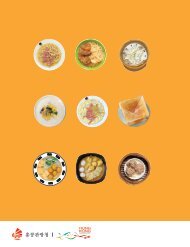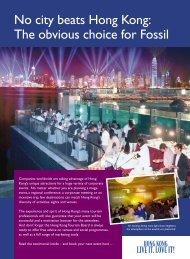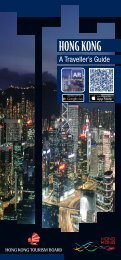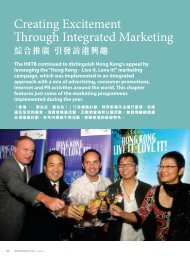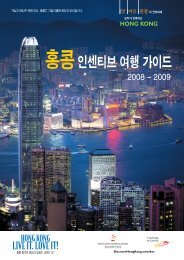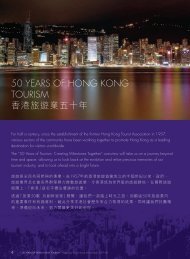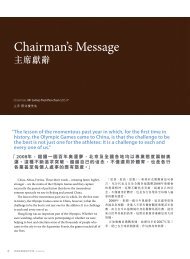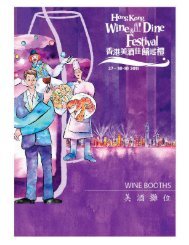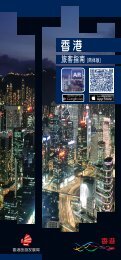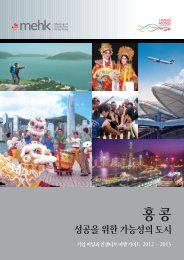Create successful ePaper yourself
Turn your PDF publications into a flip-book with our unique Google optimized e-Paper software.
Walks<br />
Eight Cultural and<br />
Historical Journeys
Asia’s world city<br />
<strong>Hong</strong> <strong>Kong</strong>, Asia’s world city, offers<br />
visitors the opportunity to experience a<br />
vibrant living culture featuring a unique<br />
fusion where ‘east-meets-west’. Instilled<br />
with an exciting duality of a modern<br />
city’s vitality enhanced by a traditional<br />
society’s historical richness and colour,<br />
this incredible destination is sure to amaze any visitor.<br />
Both dynamic and cosmopolitan, this bustling modern city features<br />
world-class infrastructure with unrivalled levels of quality tourism service.<br />
The city has everything from fantastic shopping and a delightful diversity<br />
of dining tastes to a wonderful world of colourful festivals and signature<br />
attractions. Compact and easy to navigate, it is also blessed with<br />
abundant natural beauty, where visitors can discover stunning mountain<br />
views, idyllic islands and serene beaches.<br />
This comprehensive guide features eight<br />
fascinating themed walks allowing you to<br />
experience the busy downtown streets and<br />
the flamboyant colours, sounds and aromas<br />
of local markets. You can also find serenity<br />
in a centuries-old temple, get immersed in<br />
a bygone era and then step out into this<br />
dynamic and dazzling 21 st century city to<br />
savour the rich contrast of the ancient and the modern.<br />
Captivating and charismatic, as well as fun and entertaining, <strong>Hong</strong><br />
<strong>Kong</strong> offers a multitude of fantastic experiences all within one trip. Every<br />
moment, you are guaranteed a world of different experiences that is sure<br />
to enliven your senses.<br />
1
Get Footloose in<br />
HONG KONG'S Bustling City,<br />
Rich Past and Serene Islands.<br />
<strong>Hong</strong> <strong>Kong</strong><br />
Central & Western District –<br />
Travel Through Time<br />
Garden Road Leisure Walk –<br />
A Century of Architecture<br />
Shau Kei Wan –<br />
Evolvement of a Fishing Village<br />
4<br />
12<br />
20<br />
Eight<br />
Themed<br />
Walks<br />
Kowloon<br />
Tsim Sha Tsui –<br />
Cornucopia of Delights<br />
Yau Ma Tei & Mong Kok –<br />
Markets for Leisure and Pleasure<br />
26<br />
3644<br />
Wong Tai Sin & Kowloon City –<br />
A Popular Temple & A City Transformed<br />
DISCOVER HONG KONG AR walks app series<br />
Enjoy urban distractions, rustic retreats,<br />
cultural discoveries, historical insights and more in<br />
three apps designed with self-guided tours, offline maps,<br />
augmented reality (AR) and other features to help<br />
independent travellers journey deep into the heart of Asia’s world city.<br />
<strong>Download</strong> them for<br />
<strong>Discover</strong> <strong>Hong</strong> <strong>Kong</strong> •<br />
City Walks<br />
Experience a vibrant<br />
living culture and<br />
East-meets-West<br />
diversity on four<br />
self-guided walks into<br />
the nooks and crannies<br />
of <strong>Hong</strong> <strong>Kong</strong>.<br />
NEW<br />
FREE<br />
<strong>Discover</strong> <strong>Hong</strong> <strong>Kong</strong> •<br />
Island Walks<br />
Explore <strong>Hong</strong> <strong>Kong</strong>’s<br />
scenic and culturally-rich<br />
Outlying Islands and<br />
enjoy personalisation<br />
features to create your<br />
own walks and share<br />
your experiences.<br />
now!<br />
<strong>Discover</strong> <strong>Hong</strong> <strong>Kong</strong> •<br />
Heritage Walks<br />
Powerful clans, walled<br />
villages, a fishing<br />
community and a<br />
lawless enclave –<br />
four self-guided walks<br />
through <strong>Hong</strong> <strong>Kong</strong>’s<br />
colourful history.<br />
New Territories<br />
Yuen Long –<br />
First Heritage Trail in <strong>Hong</strong> <strong>Kong</strong><br />
Fanling –<br />
Walled Village<br />
62<br />
Acknowledgements<br />
- Dr Patrick Hase<br />
- Dr Joseph Ting<br />
- Antiquities and Monuments Office<br />
- Chinese Temples Committee<br />
- Leisure and Cultural Services Department<br />
- Sik Sik Yuen Wong<br />
- Tai Sin Temple<br />
50<br />
<strong>Download</strong> the following two apps to get the content of this book on<br />
your phone, (available for Android and iPhone).<br />
The above apps developed by the <strong>Hong</strong> <strong>Kong</strong> Tourism Board are designed for offline use.<br />
Please remember TO TURN OFF DATA ROAMING to avoid unnecessary charges.<br />
<strong>Discover</strong><strong>Hong</strong><strong>Kong</strong>.com<br />
3
Western Market<br />
Central &<br />
Western District<br />
中 西 區<br />
MTR Sheung Wan Station Exit B, turn right, walk about three minutes.<br />
1. Western Market & Sheung Wan Fong<br />
西 港 城 及 上 環 坊<br />
The Western Market, an Edwardian-style building originally housing the<br />
waterfront Harbour Office when built in 1906, later became a food<br />
market before closing in 1988. Two years later, it was declared a<br />
historical monument, renovated and then re-opened in 1991 with themed<br />
shops. Next to it is a compass-like piazza named Sheung Wan Fong – a<br />
convenient spot from which to set off on your voyage of discovery of the<br />
surrounding Sheung Wan area packed with its traditional trades and<br />
unique assortment of shops. The Western Market is open daily 10am to<br />
midnight. Enquiries +852 6029 2675.<br />
Walk along Morrison Street, turn right into Wing Lok Street.<br />
TRAVEL THROUGH TIME<br />
CENTRAL & WESTERN<br />
DISTRICT<br />
2. Ginseng and Bird’s Nest Street* / Dried Seafood Street* /<br />
Herbal Medicine Street*<br />
【 參 茸 燕 窩 街 】* / 【 海 味 街 】* / 【 藥 材 街 】*<br />
Catch intriguing glimpses of daily life in <strong>Hong</strong> <strong>Kong</strong> with a stroll<br />
through time in the Central & Western District. Starting in the Western<br />
area, you’ll discover a world of wonder where the hustle and bustle<br />
of this modern city mingle with the colourful age-old traditions of<br />
yesterday. Here, among the dried seafood and Chinese herb shops,<br />
you’ll see traditions of the past that remain vibrant today. As you<br />
continue along the walk, you’ll experience time through the ages<br />
ending in Central, the financial heart of <strong>Hong</strong> <strong>Kong</strong>, full of energy<br />
and dynamism. Its modern towers of steel and glass symbolise <strong>Hong</strong><br />
<strong>Kong</strong>’s success.<br />
Note: Sections of this tour involve walks up steep hills which could be strenuous for some<br />
people.<br />
Wing Lok Street and Bonham Strand West are lined with specialty shops<br />
selling ginseng and bird’s nest. Previously known as Nam Pak <strong>Hong</strong><br />
after the Nam Pak <strong>Hong</strong> Chamber of Commerce (North-South Chamber<br />
of Commerce) located there.<br />
At the end of Wing Lok Street, turn left into Des Voeux Road West.<br />
<strong>Discover</strong> the surprising varieties of exotic dried seafood available on<br />
this street. You’ll find rare and expensive items gathered from around<br />
the world.<br />
Walk along Des Voeux Road West, turn left into Ko Shing Street. This<br />
is the wholesale centre of <strong>Hong</strong> <strong>Kong</strong>’s thriving herbal medicine trade.<br />
It is renowned for its wide selection of herbal medicine and shops with<br />
experienced staff.<br />
4 Upper: The past lives on in Central & Western District.<br />
Central & Western District<br />
*Most shops are closed on Sundays & public holidays.<br />
5
Did you know…<br />
Possession Street, also known as Shui Hang Hau, is where the British<br />
first landed when they arrived in <strong>Hong</strong> <strong>Kong</strong> in 1841 and called the<br />
spot Possession Cape. As the population grew in this area, a road<br />
was built and was named Possession Street.<br />
Did you know…<br />
If you want to know what the future holds, you can shake fortune<br />
sticks out of a bamboo cylinder available in the temple. Read an<br />
English translation of the old sayings inscribed on the sticks in the<br />
book ‘Man Mo Temple’, on sale in the temple.<br />
Walk back to Des Voeux Road West, turn right into Bonham Strand<br />
West. Then continue along Bonham Strand West, turn right into<br />
Possession Street, walk up the sloping street and turn left into<br />
Hollywood Road. Turn left at Lok Ku Road, then right onto Upper<br />
Lascar Row.<br />
Continue walking east along Hollywood Road to the Central – Mid-<br />
Levels Escalator, take the escalator up to Staunton Street and the SoHo<br />
area.<br />
3. Hollywood Road (Antiques Street) /<br />
Upper Lascar Row (Cat Street)<br />
荷 李 活 道 / 摩 羅 上 街 【 古 董 街 】<br />
Hollywood Road which links Sheung<br />
Wan to Central – and the nearby Upper<br />
Lascar Row often referred to as “Cat<br />
Street” – are famous for their curio and<br />
antiques shops. They can help you<br />
arrange getting large items back home.<br />
Walk back uphill to Hollywood Road, turn left and walk to Man Mo<br />
Temple.<br />
4. Man Mo Temple<br />
文 武 廟<br />
Accent your living room with a Chinese antique.<br />
Reach new heights on the Central – Mid-Levels Escalator.<br />
Did you know…<br />
At 800-metres long, Central – Mid-Levels Escalator is the world’s<br />
longest covered escalator. It links Des Voeux Road Central near<br />
the harbour to Conduit Road in the Mid-Levels. The escalator is a<br />
convenient way to see the bustling city hillside which contains great<br />
restaurants and shops. Travelling the entire length takes about 20<br />
minutes. The escalator runs one-way downhill from 6am to 10am,<br />
and then uphill from 10am to midnight. The escalator is a transit link<br />
for residents of the Mid-Levels. It is best to use it after 9am when the<br />
morning rush hour is over. Please be careful when the escalator is<br />
wet.<br />
One of the first traditional-style temples built<br />
during the colonial era, Man Mo Temple<br />
pays homage to the Taoist gods of literature<br />
(‘Man’) and war (‘Mo’). There is also a statue of<br />
Coils of incense within the temple create<br />
a distinctive sensory experience.<br />
Pau Kung, the god of justice, and another of Shing Wong, the god of the<br />
city. The plaques near the entrance give an interesting perspective on the<br />
history of the temple and its gods. The temple’s historical relics include a<br />
bronze bell dated 1847 and imperial sedan chairs made in 1862. It was<br />
declared a monument in 2010. Open daily 8am to 6pm. Enquiries +852<br />
2540 0350. (Free admission)<br />
5. SoHo<br />
荷 南 美 食 區<br />
This lively dining district takes its name<br />
from its location, South of Hollywood<br />
Road. SoHo consists of Shelley Street,<br />
Elgin Street, Peel Street, Staunton<br />
Street, and Old Bailey Street. Within<br />
this area you will find coffee shops, Relax with a drink in SoHo.<br />
funky bars and also a variety of chic restaurants offering a huge range<br />
of international cuisine, including Nepalese, Italian, Dutch, Spanish,<br />
Mexican, Chinese and East-West fusion.<br />
6<br />
Central & Western District<br />
7
Walk down the steps beside the escalator and turn right onto<br />
Hollywood Road, which will merge into Wyndham Street. Follow<br />
the signs into Lan Kwai Fong.<br />
6. Lan Kwai Fong<br />
蘭 桂 坊<br />
Walk along Duddell Street, cross Queen’s Road Central and walk into<br />
Ice House Street, turn right at Des Voeux Road Central and walk to the<br />
Old Supreme Court Building.<br />
8. Old Supreme Court Building<br />
舊 最 高 法 院 大 樓<br />
When the lights go<br />
down, the ‘in crowd’<br />
heads for Lan Kwai<br />
Fong, a buzzing<br />
centre of clubs, bars<br />
and restaurants. A<br />
must for night owls<br />
and people-watchers.<br />
The Old Supreme Court<br />
Building was opened 15<br />
January 1912. However,<br />
this two-storey neo-classical<br />
granite structure was<br />
renamed the Legislative<br />
Council Building in 1985 and served as such until 15 July 2011. The building<br />
will be converted into the new offices of the Court of Final Appeal, while<br />
the Legislative Council has been moved to the new Central Government<br />
Complex at Tamar in Admiralty. (Not open to the public).<br />
Walk along Jackson Road to Chater Road and then turn to Man Yiu<br />
Street. Walk to the Central pier 8 along Man Yiu Street for around<br />
10-15 minutes to the Museum.<br />
Walk up D’Aguilar Street, cross Wyndham Street and turn left into<br />
Lower Albert Road past the Fringe Club, and follow the directional signs<br />
to Duddell Street.<br />
9. <strong>Hong</strong> <strong>Kong</strong> Maritime Museum<br />
香 港 海 事 博 物 館<br />
7. Duddell Street Steps & Gas Lamps<br />
都 爹 利 街 石 階 及 煤 氣 路 燈<br />
These fine wide stone steps<br />
connect Ice House Street with<br />
Duddell Street and Queen’s<br />
Road Central beyond. The<br />
lamps at the head and foot of<br />
the steps, built between 1875<br />
and 1889, are the only four gas lamps<br />
remaining in <strong>Hong</strong> <strong>Kong</strong> and are turned on<br />
daily at 6pm.<br />
The <strong>Hong</strong> <strong>Kong</strong><br />
Maritime Museum,<br />
located at Central<br />
Ferry Pier 8, tells<br />
the rich story of the<br />
connection between<br />
the people of <strong>Hong</strong> <strong>Kong</strong> and the sea through exhibits, interactive displays,<br />
presentations and tours. With more than 2,000 years of seafaring history,<br />
there is something for everyone.<br />
The Museum opens from 9:30am to 5:30pm Monday to Friday and 10am<br />
to 7pm on weekends and public holidays. Enquiries +852 3713 2500.<br />
8 Central & Western District<br />
9
Central &<br />
Western<br />
District<br />
Walking Map
Garden Road<br />
Leisure Walk<br />
花 園 道 漫 遊<br />
MTR Admiralty Station Exit<br />
C1 and follow signs to ‘<strong>Hong</strong><br />
<strong>Kong</strong> Park / Island Shangri-La<br />
Hotel’. The park is opposite to<br />
the upper mall entrance.<br />
1. Flagstaff House (Museum of Tea Ware)<br />
舊 三 軍 司 令 官 邸 ( 茶 具 文 物 館 )<br />
A CENTURY OF ARCHITECTURE<br />
GARDEN ROAD LEISURE WALK<br />
The Central district is at the heart of <strong>Hong</strong> <strong>Kong</strong>’s development from<br />
the 19 th century to modern day and is where the headquarters of<br />
the government and the city’s financial centre are located. Garden<br />
Road abounds in culturally significant buildings steeped in <strong>Hong</strong><br />
<strong>Kong</strong>’s rich heritage, also located here are many modern buildings<br />
designed by some of the world’s top architects.<br />
Follow this walk and you’ll experience <strong>Hong</strong> <strong>Kong</strong>’s colonial past<br />
coming to life, with architecture dating back more than 150 years.<br />
You will see the centre of the current administration, including the<br />
residence of the Chief Executive plus iconic buildings that house<br />
some of <strong>Hong</strong> <strong>Kong</strong>’s leading commercial and financial giants.<br />
You can travel along <strong>Hong</strong> <strong>Kong</strong>’s historic timeline of more than a<br />
hundred years, and enjoy the rich culture on offer, at your own pace.<br />
Flagstaff House in <strong>Hong</strong> <strong>Kong</strong> Park, Central, is the oldest existing<br />
Western building in <strong>Hong</strong> <strong>Kong</strong>. Built in 1846, it was formerly known as<br />
Headquarters House. The building was renamed Flagstaff House around<br />
1932, and remained the office and residence of the Commander of the<br />
British Forces until 1978. In 1984, it was converted into the Museum<br />
of Tea Ware, displaying tea ware and related materials from a variety<br />
of periods. Open 10am to 6pm and closed on Tuesdays except public<br />
holidays. Enquiries +852 2869 0690. (Free admission)<br />
Follow the directional signs inside the park to Rawlinson House (Park<br />
Management Office and Cotton Tree Drive Marriage Registry).<br />
2. Rawlinson House (Park Management Office and Cotton<br />
Tree Drive Marriage Registry)<br />
羅 連 信 樓 ( 香 港 公 園 辦 事 處 及 紅 棉 路 婚 姻 登 記 處 )<br />
Rawlinson House was built<br />
in the early 20 th century as<br />
the residence of the Deputy<br />
Commander of the British Forces<br />
in the old Victoria Barracks. It<br />
was preserved and listed as a<br />
Grade 1 Historic Building and is<br />
now used as the Cotton Tree Drive<br />
Marriage Registry and the Park<br />
Management Office.<br />
12 Upper: Modern architecture contracts with beautiful garden scenes in Central.<br />
Garden Road Leisure Walk<br />
13
Walk up along Cotton Tree Drive. Turn<br />
right to the Lower Peak Tram Terminus<br />
when you pass the <strong>Hong</strong> <strong>Kong</strong> Squash<br />
Centre.<br />
3. Peak Tram 山 頂 纜 車<br />
Cross Garden Road via the footbridge to get to the <strong>Hong</strong> <strong>Kong</strong><br />
Zoological & Botanical Gardens.<br />
6. <strong>Hong</strong> <strong>Kong</strong> Zoological & Botanical Gardens 香 港 動 植 物 公 園<br />
The Peak Tram has been in operation since 1888 taking people up<br />
an incline so steep that buildings appear like they are leaning at a<br />
45-degree angle! Find out more at the Peak Tram Historical Gallery<br />
located at Lower Peak Tram Terminus. Open daily 7am to midnight.<br />
Enquiries +852 2522 0922.<br />
Walk along Garden Road to the Helena May Building.<br />
4. The Helena May Building<br />
梅 夫 人 婦 女 會 大 樓<br />
The Helena May Building was built in 1914, officially<br />
opened in 1916, and was used as a hostel for<br />
women. During the Second World War, the building<br />
was occupied by Japanese troops. It was reopened<br />
in 1947. Enquiries +852 2522 6766. (The building<br />
is only open to the public on special occasions. Guided tours in English<br />
and Cantonese are available on certain Saturday mornings. Advance<br />
registration is required. Call or email reception@helenamay.com.)<br />
Located opposite to the Government House, construction of these beautiful<br />
gardens started in 1860 and<br />
was fully completed in 1871.<br />
They are open every day<br />
and are a popular place to<br />
join locals as they perform<br />
their early morning tai chi<br />
exercises. There are more<br />
than 1,000 plant species<br />
in the garden and a zoo with various species of birds, mammals and<br />
reptiles. The Green House/Education and Exhibition Centre open daily<br />
from 9am to 4:30pm. Enquiries +852 2530 0154. (Free admission)<br />
Cross Upper Albert Road to Government House.<br />
7. Government House<br />
香 港 禮 賓 府<br />
Did you know…<br />
St Joseph’s College was founded in 1875, and is a government<br />
subsidised Catholic boys’ school. It had been relocated several times,<br />
and moved to its present location in 1918.<br />
St Joseph’s Church is located next to the Helena May Building.<br />
5. St Joseph’s Church 聖 約 瑟 堂<br />
St Joseph’s Church, built<br />
in 1871, has survived the<br />
onslaughts of the Second World<br />
War plus numerous typhoons.<br />
The church was demolished and rebuilt in the<br />
mid 20 th century. Open daily 7am to 7pm. Enquiries +852 2522 3992.<br />
(Free admission)<br />
Government House was formerly the<br />
office and residence of Governors<br />
of <strong>Hong</strong> <strong>Kong</strong>. Construction works<br />
started in 1851 and took four years<br />
to complete. It was originally built in the Georgian style. During the<br />
Japanese occupation, a dominant central tower was constructed to<br />
link the two original buildings; the roofs were also modified to add in<br />
more Japanese flavour, thus diminishing the strong European style of the<br />
mansion. Government House is now the residence and office of the Chief<br />
Executive of the <strong>Hong</strong> <strong>Kong</strong> Special Administrative Region. (Not open to<br />
the public except on special occasions. Please contact the Government<br />
House enquiries number at +852 2530 2003)<br />
14<br />
Garden Road Leisure Walk 15
16<br />
Garden Road Leisure Walk 17
Garden Road<br />
Walking<br />
Map
Shau Kei Wan<br />
筲 箕 灣<br />
MTR Shau Kei Wan Station Exit C,<br />
walk along Mong Lung Street and<br />
turn left into Kam Wa Street to tram<br />
terminus. Shing Wong Temple is<br />
adjacent to it. Or take tram to the<br />
Shau Kei Wan Terminus and Shing<br />
Wong Temple is right nearby.<br />
1. Shing Wong Temple 城 隍 廟<br />
The temple was originally called Fook Tak Tsz. It was<br />
built in 1877 and expanded in 1974. It is quite popular with local<br />
residents, being situated very near the Shau Kei Wan Tram Terminus.<br />
Open daily 8am to 5pm. Enquiries +852 3718 6888 (Head<br />
Office); +852 2569 2837 (Shing Wong Temple). (Free admission)<br />
Did you know…<br />
Shau Kei Wan Tram Terminus<br />
Located at the junction of Shau Kei Wan Main Street East and Kam<br />
Wa Street, this is the eastern end of the line built in 1904 that runs to<br />
Kennedy Town in the west.<br />
Walk along Shau Kei Wan Main Street East to Miu Tung Street, The Tin<br />
Hau Temple is on your right.<br />
2. Tin Hau Tample 天 后 廟<br />
EVOLVEMENT OF A FISHING<br />
VILLAGE<br />
SHAU KEI WAN<br />
In olden times, Shau Kei Wan (Shau Kei means pail and Wan means<br />
bay) provided a haven for ships and served as a typhoon shelter<br />
for fishermen. Down through the years, the area became a centre<br />
for shipbuilding and a number of temples dedicated to popular<br />
fisherfolk deities such as Tin Hau and Tam Kung sprang up. You can<br />
still visit them today and they provide great colour at festival time.<br />
This small Tin Hau Temple<br />
dedicated to the Goddess of the Sea dates<br />
back to 1873. You’ll find a collection of<br />
well preserved murals, woodcarvings and<br />
Shek Wan pottery in the temple. Open daily 8am to 5pm. Enquiries<br />
+852 3718 6888 (Head Office); +852 2569 1264 (Tin Hau Temple).<br />
(Free admission)<br />
Did you know…<br />
Shau Kei Wan Main Street East<br />
This street was originally the waterfront. In the 1860s, to crack down on<br />
pirates hiding here, the <strong>Hong</strong> <strong>Kong</strong> Government decided to clean up the<br />
area by building houses and stores on the two sides of the road.<br />
While the old houses have been replaced by modern high-rises, there<br />
are still a few old restaurants and stores on the street.<br />
20 Upper: A temple dedicated to local fishermen’s deity Tam Kung.<br />
Shau Kei Wan<br />
21
Walk along Shau Kei Wan Main Street East, turn right to A Kung Ngam<br />
Village Road and proceed along Tung Wong Road to reach Yuk Wong<br />
Temple.<br />
3. Yuk Wong Temple 玉 皇 寶 殿<br />
This temple was originally a shrine<br />
built in the mid-19 th century by people<br />
from Mainland China who worked in<br />
a nearby stone quarry. In the early<br />
1900s, the shrine was expanded<br />
into a small temple. Open daily 8am<br />
to 5pm. Enquiries +852 3718 6888<br />
(Head Office); +852 2967 9605<br />
(Yuk Wong Temple). (Free admission)<br />
Walk back along the Tam Kung Temple Road, and follow the directional<br />
signs to Tam Kung Temple.<br />
5. Tam Kung Temple<br />
譚 公 仙 聖 廟<br />
One of the few deities known only to <strong>Hong</strong> <strong>Kong</strong>, Tam Kung is also<br />
a patron of fishermen. This temple is over 100 years old and was<br />
renovated in 2002, with the original design being preserved. Besides<br />
the statue of Tam Kung, there is a small wooden junk and a dragon boat<br />
inside the temple. Open daily 8am to 5pm. Enquiries +852 2569 2559.<br />
(Free admission)<br />
Follow the directional signs, cross Tung Hei Road. Turn right and you<br />
will see the <strong>Hong</strong> <strong>Kong</strong> Museum of Coastal Defence in front of you.<br />
4. <strong>Hong</strong> <strong>Kong</strong> Museum of Coastal Defence<br />
香 港 海 防 博 物 館<br />
The Lei Yue Mun Fort built<br />
by the British in 1887<br />
to defend <strong>Hong</strong> <strong>Kong</strong><br />
against invasion by sea<br />
is home to an intriguing<br />
exhibition of military<br />
memorabilia covering the<br />
600 years from the Ming<br />
and Qing periods. It sits<br />
perched on the heights<br />
overlooking the narrow<br />
strip of water at Lei Yue Mun, now famous for its seafood restaurants.<br />
The 34,200-square-metre Museum of Coastal Defence features a<br />
Reception Area, Redoubt and Historical Trail that paint a vivid picture<br />
of Britain’s readiness to defend <strong>Hong</strong> <strong>Kong</strong> against any aggressors.<br />
Open daily (March – September) 10am to 6pm; (October – February)<br />
10am to 5pm. Closed on Thursdays (except public holidays) and during<br />
the first two days of Chinese New Year. Enquiries +852 2569 1500.<br />
(Free on Wednesdays)<br />
Did you know…<br />
Birthday of Tam Kung<br />
The birthday of Tam Kung falls on the 8 th day of the 4 th Lunar month.<br />
For many years, locals held an annual procession to commemorate<br />
the time when many people were saved from a plague with all the<br />
colour and pageantry of its origins.<br />
22<br />
Shau Kei Wan 23
Shau Kei Wan<br />
Walking<br />
Map
Tsim Sha Tsui<br />
尖 沙 咀<br />
MTR Jordan Station Exit<br />
D, turn left, walk along<br />
Nathan Road and turn left<br />
into Hillwood Road.<br />
1. Hillwood Soho<br />
山 林 道 蘇 豪 區<br />
Relax in a cosy bar.<br />
Hillwood Soho in Tsim Sha Tsui is a hangout favoured by locals, with<br />
a fun collection of bars and a selection of restaurants featuring Asian<br />
cuisine.<br />
Walk down the steps at the end of Hillwood Road, turn right and walk<br />
along Austin Avenue and Kimberley Road, stay on the right and then<br />
turn right into Observatory Road. At Knutsford Terrace, turn left.<br />
2. Knutsford Terrace / Knutsford Steps<br />
諾 士 佛 台 / 諾 士 佛 階<br />
Befitting an international eating mecca, this district is packed with people<br />
savouring the culinary delights that <strong>Hong</strong> <strong>Kong</strong> has to offer.<br />
CORNUCOPIA OF DELIGHTS<br />
TSIM SHA TSUI<br />
Tsim Sha Tsui is a tourist’s dream come true, offering everything<br />
visitors need for a trip of a lifetime. It is home to a variety of chic<br />
restaurants offering a huge range of international cuisines, plenty<br />
of large modern shopping malls, historic buildings, fascinating<br />
museums and the <strong>Hong</strong> <strong>Kong</strong> Cultural Centre. The scenic waterfront<br />
promenade offers some of the best views of Victoria Harbour and the<br />
mesmerising <strong>Hong</strong> <strong>Kong</strong> skyline.<br />
Alfresco dining at Knutsford Terrace and Knutsford Steps.<br />
26 Upper: The bright lights along Salisbury Road<br />
Tsim Sha Tsui<br />
27
Walk along Knutsford Terrace and turn left and then right along<br />
Kimberley Road. Walk to the end of the street and turn right.<br />
3. Former Kowloon British School<br />
(Antiquities and Monuments Office)<br />
前 九 龍 英 童 學 校 ( 古 物 古 蹟 辦 事 處 )<br />
This architectural gem opened<br />
in 1902 is the oldest surviving<br />
school building constructed<br />
for foreign residents of <strong>Hong</strong><br />
<strong>Kong</strong>. The building is a unique<br />
Victorian structure adapted to<br />
local climate conditions with<br />
wide verandas, high ceilings<br />
and a pitched roof. Today<br />
it houses the Antiquities and<br />
Monuments Office. Guided tour in Cantonese is available on every<br />
Friday afternoon (except public holidays). Otherwise, building is not<br />
open to the public. Enquiries +852 2208 4407.<br />
St Andrew’s Church stands next to the Former Kowloon British School.<br />
Find international brands that appeal.<br />
4. St Andrew’s Church<br />
聖 安 德 烈 堂<br />
This Anglican church has had a strong evangelical tradition for the past<br />
100 years. Early worshippers would arrive by rickshaws, cabs and<br />
sedan chairs! Accounts of the time reported that, ‘It was a great occasion<br />
for many Christians<br />
in Kowloon and their<br />
friends in <strong>Hong</strong> <strong>Kong</strong>.’<br />
Open daily 7:30am<br />
to 10:30pm. Enquiries<br />
+852 2367 1478.<br />
(Free admission)<br />
28<br />
Tsim Sha Tsui 29
Leave Kowloon Park by the same way you entered. Walk along<br />
Nathan Road towards the waterfront. Enter at MTR East Tsim Sha Tsui<br />
Station Exit L3, go through the pedestrian tunnel to Exit J, and follow<br />
the directional signs to the Avenue of Stars.<br />
7. Avenue of Stars<br />
星 光 大 道<br />
At Asia’s first Avenue<br />
of Stars, you can see<br />
plaques, hand prints<br />
and statues honouring<br />
celebrities from the<br />
silver screen, and those<br />
Find your favourite <strong>Hong</strong> <strong>Kong</strong> star.<br />
behind the camera.<br />
There is also bronze statue of the legendary kung fu action star Bruce<br />
Lee. Find out all you need to know about the 100-year development of<br />
this Hollywood of Asia and enjoy the star-studded harbour views.<br />
Did you know…<br />
You can enjoy A Symphony of Lights along the Avenue of Stars<br />
every night at 8pm. This spectacular multimedia show, named<br />
the world’s largest permanent light and sound show by Guinness<br />
World Records, combines lights and narration while featuring more<br />
than 40 buildings on both sides of Victoria Harbour. The facades<br />
of buildings are decked out in lights that, at the flick of a switch,<br />
glow in a myriad of colours depicting <strong>Hong</strong> <strong>Kong</strong>’s dynamic pulse.<br />
The Tsim Sha Tsui is home of many fascinating<br />
museums.<br />
Did you know…<br />
At the Star Ferry Pier you’ll find the HKTB Visitor Centre where you<br />
can get the answer to any question you might have about <strong>Hong</strong> <strong>Kong</strong>.<br />
A Symphony of Lights brightens the <strong>Hong</strong> <strong>Kong</strong> skyline.<br />
30<br />
Tsim Sha Tsui 31
Cross Salisbury Road to Star House and 1881 Heritage is on your right.<br />
10. 1881 Heritage<br />
Located on Canton Road, Tsim<br />
Sha Tsui, 1881 Heritage covers<br />
130,000 square feet. It features a shopping mall, a heritage hotel, and<br />
an exhibition hall. The original site of 1881 Heritage was occupied by<br />
the <strong>Hong</strong> <strong>Kong</strong> Marine Police as headquarters from 1880s to 1996.<br />
Most of the Victorian-style buildings on the site including the Former<br />
Marine Police Headquarters Main Building, Former Stable Block and<br />
the Former Time Ball Tower epitomise the city‘s rich colonial history and<br />
were declared monuments by the Antiquities and Monuments Office in<br />
1994, as proof of their historical significance. To make a reservation for<br />
the free guided tours, please call +852 2926 8000. (Free admission)<br />
Did you know…<br />
Star Ferry<br />
This floating icon, operating between <strong>Hong</strong> <strong>Kong</strong><br />
Island and Kowloon since 1898, is a delight<br />
for both children and adults, offering stunning<br />
panoramic views of the surrounding harbour.<br />
Harbour City is on the other side of Canton Road.<br />
11. Harbour City 海 港 城 / Canton Road 廣 東 道 /<br />
Peking Road 北 京 道 (Luxury Brand Streets)【 名 店 街 】<br />
Harbour City is one of the largest shopping<br />
and entertainment centres in <strong>Hong</strong> <strong>Kong</strong><br />
with more than 450 shops and restaurants<br />
offering local and international brands.<br />
Open daily 10am to 10pm. Enquiries +852<br />
2118 8666.<br />
Adjacent to Harbour City, you’ll find many leading international brands’<br />
stores along Canton Road and Peking Road. Strolling along the streets,<br />
visitors will enjoy an unrivalled luxury shopping experience.<br />
32<br />
Tsim Sha Tsui 33
Tsim Sha Tsui<br />
Walking<br />
Map
Yau Ma Tei & Mong Kok<br />
油 麻 地 及 旺 角<br />
MTR Prince Edward Station Exit C2. Walk along Prince Edward Road<br />
West to Lai Chi Kok Road. Proceed along Lai Chi Kok Road until you<br />
reach Lui Seng Chun.<br />
1. Lui Seng Chun 雷 生 春<br />
Once an old Chinese shophouse or tong lau,<br />
Lui Seng Chun is a Grade 1 historic pre-WWII<br />
building featuring a prewar verandah-type style<br />
of construction. In 2008, <strong>Hong</strong> <strong>Kong</strong> Baptist<br />
University with financial assistance from the<br />
government revitalized the building transforming it into the <strong>Hong</strong> <strong>Kong</strong> Baptist<br />
University School of Chinese Medicine – Lui Seng Chun. The building includes<br />
a herbal tea shop on the ground floor as well as a display introducing the old<br />
Lui Seng Chun. The remainder of the building is a dedicated to the practice of<br />
traditional Chinese medicine.<br />
MARKETS FOR LEISURE<br />
AND PLEASURE<br />
YAU MA TEI & MONG KOK<br />
For an experience of local Chinese lifestyles, you need to look no<br />
further than Yau Ma Tei and Mong Kok.<br />
The ground floor display areas are open free of charge from 9am to 1pm and<br />
2pm to 8pm from Monday to Saturday, and 9am to 1pm on Sundays. Closed<br />
on public holidays. Free guided tours to other floors are available by registration.<br />
For details, please visit http://scm.hkbu.edu.hk/lsc or call +852 3411 0628.<br />
Walk along Lai Chi Kok Road to MTR Prince Edward Station Exit B1.<br />
Proceed along Prince Edward Road West to Yuen Po Street Bird<br />
Garden. Pass through the garden to the junction of Yuen Po Street<br />
and Flower Market Road. At the end of the road, get on Prince Edward<br />
Road West and walk along Tung Choi Street until you reach the<br />
Goldfish Market.<br />
Walking through this unique section of <strong>Hong</strong> <strong>Kong</strong> is an exciting and<br />
memorable experience any time of the day or night. You’ll love the<br />
ambience and the great deals you can get on souvenirs, clothing,<br />
electronic goods and much more.<br />
36 Upper: The bright lights above the Temple Street Night Market in Yau Ma Tei.<br />
Yau Ma Tei & Mong Kok<br />
37
2. Yuen Po Street Bird Garden / Flower Market / Goldfish Market<br />
園 圃 街 雀 鳥 花 園 / 花 墟 / 通 菜 街 ( 北 段 )【 金 魚 街 】<br />
The charming Chinese-style garden on Yuen<br />
Po Street includes some 70 songbird stalls<br />
as well as courtyards and moon gates. Look<br />
and listen, but it’s wise to avoid contact<br />
with the birds.The Bird Market is open daily<br />
7am to 8pm. The colourful Flower Market<br />
sells everything from Dutch tulips to exotic<br />
orchids. Open daily from 7am to 7pm. The<br />
Goldfish Market on nearby Tung Choi Street<br />
sells aquariums, corals and exotic fish. Open<br />
daily 10:30am to 10pm.<br />
A rainbow of colours at the Flower Market<br />
in Mong Kok.<br />
Did you know…<br />
Some Interesting Street Names<br />
You can glimpse the past history of Mong Kok by checking street<br />
signs. The names are a colourful reminder of the bygone days. There<br />
is Yuen Po Street (Vegetable Patch Street), Sai Yeung Choi Street<br />
(Watercress Street) and Yuen Ngai Street. Nothing remains of the old<br />
Mong Kok village but these street names.<br />
Walk along Fa Yuen Street to Mong Kok Road, turn right and cross the<br />
road to reach another section of Tung Choi Street, walk to Argyle Street<br />
and cross the road to reach the starting point of the Ladies’ Market.<br />
4. Ladies’ Market<br />
Ladies’ Market has something for everyone with<br />
bargain-priced items, including men’s and<br />
women’s clothing, knick-knacks, watches and<br />
beauty products. Beside the street stalls are<br />
<strong>Hong</strong> <strong>Kong</strong>-style cafes that offer local favourites.<br />
Open daily noon to 11:30pm.<br />
Walk through the Ladies’ Market to its end at Dundas Street. Turn right<br />
and walk to the junction of Shanghai Street and Waterloo Road.<br />
5. Yau Ma Tei Theatre<br />
油 麻 地 戲 院<br />
Shopping in <strong>Hong</strong> <strong>Kong</strong> is exhilarating!<br />
Proceed along Tung Choi Street turning left into Bute Street and then<br />
right into Fa Yuen Street.<br />
3. Fa Yuen Street<br />
Fa Yuen Street is the place to be if you<br />
want to find bargain-priced trendy<br />
fashion and casual wear for men,<br />
women and children. Open daily 11am<br />
to 9:30pm.<br />
Shop till you drop in Fa Yuen Street.<br />
Did you know…<br />
Tung Choi means ‘water spinach’ reflecting the street’s rural origins.<br />
Imagine, this street used to be farmland!<br />
Built in 1930, the Yau Ma Tei Theatre<br />
is the only surviving pre-war cinema<br />
building in the urban area of <strong>Hong</strong><br />
<strong>Kong</strong>. The theatre closed down in<br />
1998 and was listed as a historic<br />
building in the same year.<br />
Now, the building has been reopened as a venue dedicated to Cantonese<br />
opera and features young up-and-coming performers. And, some of the<br />
shows come with English surtitles, so non-Cantonese speakers can also<br />
enjoy the action on stage.<br />
After your visit to the theatre, don’t<br />
miss the attractive red brick building<br />
on the opposite side of Shanghai<br />
Street, which houses the theatre’s<br />
administration offices. Yau Ma Tei<br />
Theatre is open daily 1pm to 8pm.<br />
Enquiries + 852 2264 8108. (Free<br />
admission)<br />
38<br />
Yau Ma Tei & Mong Kok 39
Walk along the Shanghai Street.<br />
6. Shanghai Street<br />
This is one of the city’s oldest streets. Look<br />
for shops selling Chinese-style wedding<br />
clothes which feature stunning embroidery.<br />
Once there were many of these shops, now<br />
just a few remain. It’s also a great place to<br />
pick up bargain kitchenware.<br />
Continue along Shanghai Street, turn right at Kansu Street to the Jade<br />
Market.<br />
7. Jade Market / Jade Street<br />
玉 器 市 場 / 玉 器 街<br />
Traditional Chinese wedding clothing<br />
Go back to Shanghai Street, walk north to the junction of Shanghai and<br />
Public Square streets, turn right and walk to the Tin Hau Temple.<br />
8. Tin Hau Temple<br />
天 后 廟<br />
This temple is dedicated to<br />
the Goddess of Seafarers,<br />
Tin Hau. Its location in the<br />
middle of urban Yau Ma<br />
Tei might seem odd, but<br />
long ago, before massive<br />
reclamation, it was on the<br />
harbour front. The water has receded, but people continue to worship<br />
Tin Hau here. Open daily 9am to 5pm. Enquiries +852 2385 0759.<br />
(Free admission)<br />
Walk up Temple Street, across from the temple.<br />
About 400 registered stall-owners sell amulets,<br />
ornaments, necklaces and trinkets made<br />
from the revered green stone. This is a fun<br />
place to browse and to buy an inexpensive<br />
memento of your visit, but think twice about<br />
buying anything costly unless you are a jade<br />
expert. Open daily 10am to 5pm.<br />
A fun place to brouse and hunt for an<br />
inexpensive souvenir.<br />
Nearby is Jade Street, located on Canton Road between Kansu Street<br />
and Jordan Road, where shops are open 10am to 4pm Monday to<br />
Saturday. A giant jade stone weighing three tons has been placed at the<br />
junction of Canton Road and Jordan Road as a landmark.<br />
Did you know…<br />
Many Chinese people believe that jade can protect you from evil<br />
spirits and calm your emotions. That’s why they buy tiny jade<br />
bracelets for their babies.<br />
9. Temple Street Night Market<br />
廟 街 夜 市<br />
This is the famous night market, open daily 4pm to midnight, where you<br />
can find all kinds of bargains, including casual clothes and curios. You’ll<br />
also often see fortune tellers,<br />
Cantonese opera singers and<br />
professional Chinese chess<br />
players. The market becomes<br />
busy after sunset. Two New<br />
Chinese Pai Laus (archway)<br />
have been erected at its<br />
junctions with Jordan Road<br />
and Kansu Street.<br />
When the sun goes down, the bargains come<br />
out at the Temple Street Night Market.<br />
40<br />
Yau Ma Tei & Mong Kok 41
Yau Ma Tei<br />
&<br />
Mong Kok<br />
Walking<br />
Map
Wong Tai Sin & Kowloon City<br />
黃 大 仙 及 九 龍 城<br />
Take MTR to Diamond Hill Station. Leave the station by Exit C2 and<br />
follow the directional signs pointing to the Nan Lian Garden.<br />
1. Nan Lian Garden and Chi Lin Nunnery<br />
南 蓮 園 池 及 志 蓮 淨 苑<br />
A POPULAR TEMPLE &<br />
A CITY TRANSFORMED<br />
WONG TAI SIN & KOWLOON<br />
CITY<br />
Wong Tai Sin District gets its name from the famous Sik Sik Yuen<br />
Wong Tai Sin Temple, the area’s most prominent landmark. Other<br />
places of interest include the Hau Wong Temple dating back to the<br />
Qing dynasty and Nan Lian Garden, which is built in the ancient<br />
Tang dynasty style.<br />
The neighbouring Kowloon City District used to contain the Kowloon<br />
Walled City, which was torn down in 1994 and replaced by a<br />
lovely park of the same name.<br />
Right nearby are a series of 10 streets packed with upwards of 200<br />
local eateries, all serving up the delicious tastes of <strong>Hong</strong> <strong>Kong</strong>.<br />
This classical landscaped garden<br />
is a scenic oasis in Diamond Hill<br />
spanning some 35,000 square<br />
metres. Styled to mimic a Tang<br />
dynasty (AD 618 - 907) garden,<br />
its Lotus Pond and Blue Pond<br />
are the main attractions, with<br />
other water features, hillocks,<br />
old trees, ornamental rocks and<br />
ancient timber architectures<br />
providing a picturesque complement. Strolling along a one-way circular<br />
route, visitors will see the beautiful landscape unfolding with each step.<br />
Visitors can top off a walk with a bite to eat at Chi Lin Vegetarian in<br />
Long Men Lou, for a genuine and delicious meat-free meal. Walkers<br />
can also appreciate Chinese tea-drinking culture and etiquette at the<br />
Pine Teahouse, Song Cha Xie, inside this lovely green haven. The<br />
garden is open daily from 7am to 9pm. Enquiries +852 3658 9312.<br />
(Free admission)<br />
Next to Nan Lian Garden sits the Chi Lin Nunnery. Established<br />
in 1934 and also renovated to the Tang dynasty style in 1990,<br />
Chi Lin Nunnery is a large temple complex of elegant wooden<br />
architecture, treasured Buddhist relics and soul-soothing lotus ponds.<br />
The complex also includes a series of temple halls, some of which<br />
contain gilded and wooden statues representing divinities such as the<br />
Shakyamuni Buddha and bodhisattvas. The temple hall area opens<br />
daily 9am to 4:30pm. The Lotus Garden opens daily 7am to 7pm.<br />
Enquiries +852 2354 1888. (Free admission)<br />
44 Upper: Thousands of worshippers attend Wong Tai Sin Temple.<br />
Wong Tai Sin & Kowloon City<br />
45
Other points of interest:<br />
The five buildings and structures representing<br />
the ‘Five Geomantic Elements’ of Fung Shui:<br />
the Bronze Pavilion (Metal), the Archives Hall<br />
(Wood), the Fountain (Water), the Yue Heung<br />
Shrine (Fire) and the Earth Wall (Earth). Open<br />
daily from 7am to 5:30pm. (The Tai Shui<br />
Yuenchen Hall is open daily 8am to 5pm).<br />
Enquiries +852 2327 8141. (Free admission<br />
except the Tai Shui Yuenchen Hall)<br />
46<br />
Take MTR to Wong Tai Sin Station, leave the station by Exit B3 and follow<br />
directional signs pointing to the Sik Sik Yuen Wong Tai Sin Temple.<br />
2. Sik Sik Yuen Wong Tai Sin Temple<br />
(Wong Tai Sin) 嗇 色 園 黃 大 仙 祠 ( 黃 大 仙 )<br />
This is one of the most popular temples in <strong>Hong</strong> <strong>Kong</strong>. According to<br />
legend, Wong Tai Sin is able to ‘make<br />
every wish come true upon request’. The<br />
temple is home to three different religions:<br />
Taoism, Buddhism and Confucianism. The<br />
temple containing Wong Tai Sin’s portrait<br />
is where worshippers pray for good fortune<br />
through offerings and divine guidance as<br />
well as through fortune telling.<br />
Take MTR to Lok Fu Station, leave the station by Exit B and follow the<br />
directional signs pointing to the Hau Wong Temple.<br />
3. Hau Wong Temple<br />
侯 王 廟<br />
The Earth Wall<br />
One of the legends surrounding<br />
this temple, built in 1730 during<br />
the Qing dynasty says, it was to<br />
commemorate a Chinese general<br />
who had helped the last Song<br />
Emperor to escape the invading forces to Kowloon. Another legend says it was<br />
dedicated to a local inhabitant who had cured the last emperor of the Southern<br />
Song dynasty. The temple is home to a wealth of cultural artifacts including<br />
groups of reliefs on the walls, Chinese calligraphy and a number of plaques.<br />
Open daily 8am to 5pm. Enquiries +852 3718 6888 (Head Office); +852<br />
2336 0375 (Hau Wong Temple). (Free admission)<br />
Cross the road, walk along Tung Tau Tsuen Road to reach the North<br />
Gate of Kowloon Walled City Park.<br />
4. Kowloon Walled City Park<br />
九 龍 寨 城 公 園<br />
The Kowloon Walled City Park sits on the site<br />
of the Kowloon Walled City, which by a quirk<br />
of history remained outside British jurisdiction<br />
after <strong>Hong</strong> <strong>Kong</strong> became a colony.<br />
The South Gate of this Chinese-style park<br />
remnants with the original stone plaques and<br />
the pre-war concrete relics fully demonstrate<br />
the evolution of the City. The yamen, or<br />
administrative building, which is one of<br />
the very few surviving structures of its kind in South China, has been<br />
restored and preserved in-situ. Other significant surviving relics include<br />
two cannons (made in 1802) which are positioned at either end of the<br />
Yamen‘s front yard. The Garden of the Chinese Zodiac, the Chess<br />
Garden, the Mountain View Pavilion, the Kuixing Pavilion and Guibi<br />
Rock, Eight Floral Walks and the Garden of Four Seasons are six other<br />
landscape features worth appreciation. Open daily 6:30am to 11pm.<br />
Enquiries +852 2716 9962. (Free admission)<br />
Walk through the Kowloon Walled City Park and Carpenter Road<br />
Park. Cross Carpenter Road to reach Nam Kok Road, i.e. the<br />
Kowloon City Food District.<br />
5. Kowloon City Food District 九 龍 城 美 食 區<br />
A group of around 10 streets bounded<br />
by Prince Edward Road West, Junction<br />
Road and Carpenter Road is where you<br />
can find around 200 inexpensive and<br />
often family-run eateries serving local<br />
favourites, Southeast Asian dishes as<br />
well as cuisines from around the world.<br />
Take the Green Minibus 25M on Sa Po Road (beside Regal Oriental<br />
Hotel) to MTR Kowloon Tong Station and take the MTR train back to<br />
your hotel or other sightseeing destinations.<br />
Did you know…<br />
Former Kai Tak Airport<br />
The hair-raising landings at the former international airport at Kai Tak are<br />
a thing of the past with its former runway having been redeveloped into a<br />
state-of-the-art cruise terminal . The cruise terminal roof top garden is open to<br />
the public and free of charge.<br />
Wong Tai Sin & Kowloon City 47
Wong Tai Sin<br />
&<br />
Kowloon<br />
City<br />
Walking Map
Yuen Long<br />
元 朗<br />
Ping Shan Heritage Trail<br />
屏 山 文 物 徑<br />
MTR Tin Shui Wai Station Exit E. When<br />
you arrive at the ground floor, cross Tsui<br />
Sing Road. You will see Tsui Sing Lau<br />
Pagoda.<br />
1. Tsui Sing Lau Pagoda<br />
聚 星 樓<br />
FIRST HERITAGE<br />
TRAIL IN HONG KONG<br />
YUEN LONG<br />
Yuen Long, located in the northwest New Territories, has been<br />
transformed from a market town into a modern new town filled<br />
with residential and commercial developments. But the district still<br />
harbours incredible vestiges of <strong>Hong</strong> <strong>Kong</strong>’s past. Many heritage<br />
sites are still well preserved. The various centuries-old ancestral halls<br />
provide a rich vein of information about the early clan settlers in the<br />
New Territories. All of these heritage sites offer a wonderful way to<br />
literally step back in time and revisit the early days of Asia’s world<br />
city.<br />
<strong>Hong</strong> <strong>Kong</strong>’s oldest pagoda, it is believed to have been built in about<br />
1486. The three-storey, green brick building is hexagonal shaped and<br />
stands 13 metres high. The top floor of the pagoda is home to Fui Shing<br />
(Champion Star) who is believed to be the deity in charge of success or<br />
failure in examinations. You will also see auspicious sayings inscribed<br />
on each floor. Open daily 9am to 1pm and 2pm to 5pm. Closed on<br />
Tuesdays and some public holidays. (Free admission)<br />
Did you know…<br />
Ping Shan Heritage Trail<br />
Originally Ping Shan was used to denote a number of villages<br />
situated below the Ping Shan Police Station. These included Sheung<br />
Cheung Wai, Kiu Tau Wai, Fui Sha Wai, Hang Tau Tsuen, Hang<br />
Mei Tsuen, Hung Uk Tsuen and Tong Fong Tsuen. But now, Ping Shan<br />
covers a much larger area.<br />
Follow the ‘Ping Shan Heritage Trail’ sign. Turn left and walk in the<br />
direction of the Tung Wah Group of Hospitals Kwok Yat Wai College.<br />
Follow the sign to Sheung Cheung Wai.<br />
50 Upper: Yu Kiu Ancestral Hall.<br />
Yuen Long<br />
51
2. Shrine of the Earthgod<br />
社 壇<br />
Just before you enter Sheung<br />
Cheung Wai you will come across<br />
a shrine dedicated to the Earthgod,<br />
She Kung, the deity that villagers<br />
believe protects their villages and<br />
homes. The shrines are usually simple brick structures on which pieces of<br />
stone are placed to symbolise the presence of the god.<br />
Turn left at the Shrine of the Earth God.<br />
3. Sheung Cheung Wai<br />
上 璋 圍<br />
This 200-year-old walled village is<br />
the only such village along the entire<br />
heritage trail. It consists of rows of<br />
symmetrical houses enclosed by a<br />
green brick wall. The gatehouse,<br />
shrines and some of the old houses<br />
are still standing. Part of the wall has been demolished but enough<br />
remains to give a good taste of a traditional Chinese walled village.<br />
Sheung Cheung Wai is private property and not open to the public.<br />
Follow the signs and turn right at the first junction and turn left at the<br />
second junction. Yeung Hau Temple is located on your left.<br />
4. Yeung Hau Temple<br />
楊 侯 古 廟<br />
Located in Hang Tau Tsuen, this temple is<br />
dedicated to the deity Hau Wong. The exact<br />
date of construction is unknown but renovations<br />
were undertaken in 1963 and 1991. The<br />
temple is divided into three bays housing the<br />
statues of Hau Wong, Kam Fa (Patron Saint<br />
of Expectant Mothers) and To Tei (God of the<br />
Earth).<br />
52<br />
Yuen Long 53
Go back to the last junction and turn left. Walk along the road and you<br />
will see the Tang Ancestral Hall.<br />
Follow the sign to Kun Ting Study Hall and Ching Shu Hin. Enter the Kun<br />
Ting Study Hall from the side entrance.<br />
5. Tang Ancestral Hall<br />
鄧 氏 宗 祠<br />
First constructed in 1273, this Tang clan Ancestral Hall is a magnificent<br />
three-hall structure with two internal courtyards, and is one of the finest<br />
examples of such a building in <strong>Hong</strong> <strong>Kong</strong>. Worth noting is the elevated<br />
pathway in the front courtyard indicating that one of the Tang clansmen<br />
held a high-ranking position in the Imperial government. Open daily<br />
9am to 1pm and 2pm to 5pm. Closed during the first three days of the<br />
Lunar New Year.<br />
Yu Kiu Ancestral Hall is next to the Tang Ancestral Hall.<br />
6. Yu Kiu Ancestral Hall<br />
愈 喬 二 公 祠<br />
Situated immediately to the south of the<br />
Tang Ancestral Hall, it was constructed<br />
in the early 16 th century by two 11 th<br />
generation Tang clan brothers. Apart<br />
from being an ancestral hall it also<br />
served as a school for kids in the Ping<br />
Shan villages. The layout and design<br />
of this building is identical to the Tang<br />
Ancestral Hall with its three halls and<br />
two internal courtyards. Open daily 9am to 1pm and 2pm to 5pm.<br />
Closed during the first three days of the Lunar New Year.<br />
7. Kun Ting Study Hall<br />
覲 廷 書 室<br />
Used both for ancestor worship and as a study hall, this 1870s edifice<br />
is a stunning piece of craftsmanship. It is a two-hall building with an<br />
enclosed courtyard, noteworthy for its finely carved granite columns and<br />
granite block base along the facade. The distinguished design of the<br />
ancestral hall inside the Study Hall reflects the work of skilled craftsmen<br />
of that period.<br />
Ching Shu Hin is next to the Kun Ting Study Hall.<br />
8. Ching Shu Hin<br />
清 暑 軒<br />
This 1874 building was intended as<br />
a guesthouse for prominent scholars<br />
and visitors. It is a memorable<br />
feast for the eyes, decorated with<br />
carved panels, murals, patterned<br />
grilles, carved brackets and plaster<br />
mouldings – fully demonstrating the<br />
grandeur and elegance of a rich<br />
Chinese family’s residence.<br />
54<br />
Yuen Long 55
Turn left to Ping Ha Road. Walk along the road and the Hung Shing<br />
Temple is next to Hang Mei Tsuen Park.<br />
Hidden Treasures of Yuen Long<br />
9. Hung Shing Temple<br />
洪 聖 宮<br />
Hung Shing is widely worshipped, particularly by fishermen and people<br />
whose livelihoods depend upon the sea. The temple, built by the Tang<br />
clan in 1767, is a simple two-hall building with an open courtyard in<br />
between – unlike most other temples in <strong>Hong</strong> <strong>Kong</strong>, where the open<br />
courtyards are roofed over to form incense towers.<br />
Did you know…<br />
Retrace your steps and follow the signs to the Light Rail Hang Mei<br />
Tsuen Station, take Route 761P and alight at Tai Tong Road Station.<br />
Here you will discover a wonderful world of hidden treasures in Yuen<br />
Long. See pages 57-58 for further details.<br />
56<br />
Yuen Long 57
2. Wife Cakes<br />
The delightfully-named wife cakes are buns filled with sweet winter<br />
melon paste. Legend has it that when the winter-melon puffs made<br />
by a woman in Guangdong Province were highly praised in public,<br />
her husband proudly declared that there were his wife’s cakes. The<br />
name ‘wife cake’ stuck.<br />
In <strong>Hong</strong> <strong>Kong</strong>, back when the New Territories was a day trip away<br />
from the urban areas, it was de rigueur for visitors to Yuen Long to<br />
buy wife cakes to take home. Today, a lot of the city’s wife cakes<br />
are baked in Yuen Long, so this is still considered the place to get<br />
the freshest batches.<br />
58<br />
Yuen Long 59
Ping Shan<br />
Heritage<br />
Trail<br />
C<br />
M<br />
Y<br />
CM<br />
MY<br />
CY<br />
CMY<br />
K
Fanling<br />
粉 嶺<br />
MTR Fanling Station. Look for the<br />
temple‘s distinctive orange double roof.<br />
1. Fung Ying Seen Koon<br />
蓬 瀛 仙 館<br />
Dominating the skyline from its commanding site on a hillside overlooking<br />
the New Territories town of Fanling, the temple is a superb example of<br />
Taoist design and craftsmanship. Open daily 8:30am to 5pm. Enquiries<br />
+852 2669 9186. (Free admission)<br />
Go back to MTR Fanling Station and follow the sign to ‘Luen Wo<br />
Hui’. Turn left and go downstairs to the Green Minibus station and<br />
take Green Minibus 54K to Lung Yeuk Tau and alight at Shung<br />
Him Tong.<br />
2. Shung Him Tong<br />
崇 謙 堂<br />
WALLED VILLAGE<br />
FANLING<br />
With the rapid development of Fanling, the fields are pretty<br />
much gone, and the New Town is now filled with residential and<br />
commercial blocks. Culture and heritage buffs will be delighted with<br />
the cornucopia of treasures to see, including a stunning Taoist temple<br />
and a number of walled villages. It’s also fun to walk around in the<br />
nearby shopping mall and check out the local eateries and shops for<br />
a real slice of modern-day <strong>Hong</strong> <strong>Kong</strong> life.<br />
Hakka Lutherans founded this village in<br />
1901 after escaping persecution. Of note<br />
is the fine Tsung Kyam Church (Tsung Kyam<br />
is the Hakka pronunciation of Shung Him),<br />
the only church with services in Hakka.<br />
Shung Him Tong is private property and not open to the public.<br />
Did you know…<br />
A Prestigious Marriage<br />
During the 12 th century, a Tang clan man rescued a young girl fleeing<br />
the invading Mongols. When she grew up, he arranged for her to<br />
marry his son. When peace and security was restored, she informed<br />
her husband that she was in fact related to royalty and was the daughter<br />
of the Emperor. Luckily, the Emperor was inclined to look favourably on<br />
the marriage and let it stand, giving her husband a suitable title and<br />
large estate to provide for his daughter. Most of the Tangs resident in<br />
the New Territories today are descended from their five sons.<br />
Upper: Fung Ying Seen Koon is one of the most<br />
62 important Tooist temple complexes in <strong>Hong</strong> <strong>Kong</strong>.<br />
Fanling<br />
63
Walk along the route to Ma Wat Wai, which is next to Ma Wat Wai<br />
children’s playground.<br />
3. Ma Wat Wai<br />
麻 笏 圍<br />
Walk along the route to Tang Chung Ling Ancestral Hall.<br />
5. The Tang Chung Ling Ancestral Hall<br />
松 嶺 鄧 公 祠<br />
At Ma Wat Wai, check out the<br />
gatehouse with its gun platform over the<br />
gate, dating back to about 1740. It’s<br />
made of thick plated wrought iron in two<br />
leaves with allows air to circulate and provides a good deal of strength<br />
at the same time. Access to the village is through a single narrow gate<br />
on the northwest side. The entrance gate of Ma Wat Wai became a<br />
Declared Monument in 1994.<br />
Walk along the route to Lo Wai.<br />
4. Lo Wai<br />
老 圍<br />
This old walled village is a must-visit in Lung<br />
Yeuk Tau, featuring thick walls accessible only<br />
through the single narrow gateway on the<br />
east side. The walls and the gatehouse have<br />
been restored recently and are Declared Monuments. The gatehouse<br />
contains a shrine to the Earthgod and has a gun platform above, but the<br />
village’s small canon is no longer. Several old houses within the walled<br />
village are still occupied. To avoid disturbing local residents, the interior<br />
of Lo Wai is not open to the public. Open daily 9am to 5pm (Lo Wai<br />
entrance).<br />
Did you know…<br />
Lung Yeuk Tau Heritage Trail<br />
The Sung dynasty Princess and her Tang clan husband settled in<br />
Lung Yeuk Tau in the 13 th century. Today his descendants occupy 11<br />
villages in the area, five of which are walled.<br />
This Declared Monument is a superb<br />
building, originally built in 1570 and<br />
rebuilt around 1700. It includes an<br />
Ancestral Hall that is a perfect example<br />
of the ‘Gentry Ancestral Hall’ or a hall for<br />
the descendants of some high officials<br />
(in this case the descendents of the Song Princess and her husband).<br />
The building is decorated with magnificent artworks and the construction<br />
style is elegant. There is also an Imperial Tablet dedicated to the Sung<br />
Princess and her husband, the only such tablet in <strong>Hong</strong> <strong>Kong</strong>. Open<br />
daily 9am to 1pm and 2pm to 5pm. Closed on Tuesdays and some<br />
public holidays.<br />
Tin Hau Temple is next to the Tang Chung Ling Ancestral Hall.<br />
6. Tin Hau Temple<br />
天 后 宮<br />
The local Tin Hau Temple is an excellent piece of workmanship, entirely<br />
traditional in form and<br />
decoration. It was last<br />
restored in 1981. Tin Hau,<br />
protector of fishermen and<br />
one of <strong>Hong</strong> <strong>Kong</strong>’s most<br />
popular deities, is in the<br />
Main Hall while Kam Fa,<br />
goddess of childbirth, is<br />
in the side hall. Note the<br />
magnificent wall orchid<br />
that has been growing for the past 70 years.<br />
Take Green Minibus 54K back to MTR Fanling Station and take MTR<br />
back to town.<br />
64<br />
Fanling 65
Fanling<br />
Walking Map
<strong>Hong</strong> <strong>Kong</strong> Tourism Board Visitor Information Services<br />
<strong>Hong</strong> <strong>Kong</strong> International Airport Visitor Centre<br />
• Buffer Halls A and B, Arrivals Level, Terminal 1<br />
8am – 9pm daily<br />
Kowloon Visitor Centre<br />
• Star Ferry Concourse, Tsim Sha Tsui<br />
8am – 8pm daily<br />
<strong>Hong</strong> <strong>Kong</strong> Island Visitor Centre<br />
• The Peak Piazza (between The Peak Tower and The Peak Galleria)<br />
11am – 8pm daily<br />
Lo Wu Information Centre<br />
• Arrival Hall, 2/F, Lo Wu Terminal Building<br />
Information is correct as of February 2014, but is subject to change without<br />
prior notice.<br />
<strong>Hong</strong> <strong>Kong</strong> Tourism Board disclaims any liability for the quality or fitness for<br />
the purpose of third-party products or services; or for any errors or omissions.<br />
© Copyright <strong>Hong</strong> <strong>Kong</strong> Tourism Board 2014<br />
68
Printed for the <strong>Hong</strong> <strong>Kong</strong> Tourism Board, English, February 2014 (1523)




